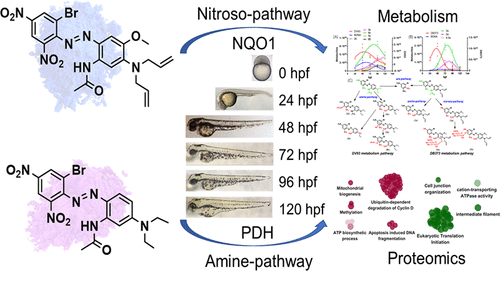当前位置:
X-MOL 学术
›
Environ. Sci. Technol.
›
论文详情
Our official English website, www.x-mol.net, welcomes your
feedback! (Note: you will need to create a separate account there.)
Toxicokinetics of Brominated Azo Dyes in the Early Life Stages of Zebrafish (Danio rerio) Is Prone to Aromatic Substituent Changes.
Environmental Science & Technology ( IF 10.8 ) Pub Date : 2020-03-24 , DOI: 10.1021/acs.est.9b07178 Jiajun Han 1 , Diwen Yang 1 , David Ross Hall 1, 2 , Jiabao Liu 3 , Jianxian Sun 1 , Wen Gu 4 , Song Tang 4 , Hattan A Alharbi 5 , Paul D Jones 6 , Henry M Krause 3, 7 , Hui Peng 1, 2
Environmental Science & Technology ( IF 10.8 ) Pub Date : 2020-03-24 , DOI: 10.1021/acs.est.9b07178 Jiajun Han 1 , Diwen Yang 1 , David Ross Hall 1, 2 , Jiabao Liu 3 , Jianxian Sun 1 , Wen Gu 4 , Song Tang 4 , Hattan A Alharbi 5 , Paul D Jones 6 , Henry M Krause 3, 7 , Hui Peng 1, 2
Affiliation

|
Brominated azo dyes (BADs) have been identified as predominant indoor brominated pollutants in daycare dust; thus, their potential health risk to children is of concern. However, the toxicities of BADs remain elusive. In this study, the toxicokinetics of two predominant BADs, Disperse Blue 373 (DB373) and Disperse Violet 93 (DV93), and their suspect metabolite 2-bromo-4,6-dinitroaniline (BDNA) was investigated in embryos of zebrafish (Danio rerio). The bioconcentration factor of DV93 at 120 hpf is 6.2-fold lower than that of DB373. The nontarget analysis revealed distinct metabolism routes between DB373 and DV93 by reducing nitro groups to nitroso (DB373) or amine (DV93), despite their similar structures. NAD(P)H quinone oxidoreductase 1 (NQO1) and pyruvate dehydrogenase were predicted as the enzymes responsible for the reduction of DB373 and DV93 by correlating time courses of the metabolites and enzyme development. Further in vitro recombinant enzyme and in vivo inhibition results validated NQO1 as the enzyme specifically reducing DB373, but not DV93. Global proteome profiling revealed that the expression levels of proteins from the “apoptosis-induced DNA fragmentation” pathway were significantly upregulated by all three BADs, supporting the bioactivation of BADs to mutagenic aromatic amines. This study discovered the bioactivation of BADs via distinct eukaryotic enzymes, implying their potential health risks.
中文翻译:

斑马鱼早期生活中溴化偶氮染料的毒代动力学(Danio rerio)易于发生芳香取代基变化。
溴偶氮染料(BADs)已被确定为日托粉尘中主要的室内溴化污染物。因此,他们对儿童的潜在健康风险值得关注。但是,BADs的毒性仍然难以捉摸。在这项研究中,两种主要BADS的毒物动力学,分散蓝373(DB373)和分散紫93(DV93),和它们的代谢物疑2-溴-4,6-二硝基苯胺(BDNA)在斑马鱼胚胎进行了研究(斑马鱼)。DV93在120 hpf下的生物富集系数比DB373低6.2倍。非目标分析显示,尽管结构相似,但通过将亚硝基还原为亚硝基(DB373)或胺(DV93),DB373和DV93之间存在独特的代谢途径。NAD(P)H醌氧化还原酶1(NQO1)和丙酮酸脱氢酶被预测为负责通过关联代谢产物的时间过程和酶发展来减少DB373和DV93的酶。进一步的体外重组酶和体内抑制结果验证了NQO1是特异性还原DB373而不是DV93的酶。全球蛋白质组分析显示,所有三种BAD均显着上调了“细胞凋亡诱导的DNA片段化”途径中蛋白质的表达水平,支持BAD对诱变的芳香胺的生物活化。这项研究发现了BADs通过独特的真核生物酶的生物激活,暗示了其潜在的健康风险。
更新日期:2020-03-26
中文翻译:

斑马鱼早期生活中溴化偶氮染料的毒代动力学(Danio rerio)易于发生芳香取代基变化。
溴偶氮染料(BADs)已被确定为日托粉尘中主要的室内溴化污染物。因此,他们对儿童的潜在健康风险值得关注。但是,BADs的毒性仍然难以捉摸。在这项研究中,两种主要BADS的毒物动力学,分散蓝373(DB373)和分散紫93(DV93),和它们的代谢物疑2-溴-4,6-二硝基苯胺(BDNA)在斑马鱼胚胎进行了研究(斑马鱼)。DV93在120 hpf下的生物富集系数比DB373低6.2倍。非目标分析显示,尽管结构相似,但通过将亚硝基还原为亚硝基(DB373)或胺(DV93),DB373和DV93之间存在独特的代谢途径。NAD(P)H醌氧化还原酶1(NQO1)和丙酮酸脱氢酶被预测为负责通过关联代谢产物的时间过程和酶发展来减少DB373和DV93的酶。进一步的体外重组酶和体内抑制结果验证了NQO1是特异性还原DB373而不是DV93的酶。全球蛋白质组分析显示,所有三种BAD均显着上调了“细胞凋亡诱导的DNA片段化”途径中蛋白质的表达水平,支持BAD对诱变的芳香胺的生物活化。这项研究发现了BADs通过独特的真核生物酶的生物激活,暗示了其潜在的健康风险。











































 京公网安备 11010802027423号
京公网安备 11010802027423号